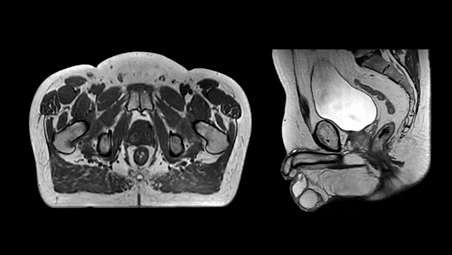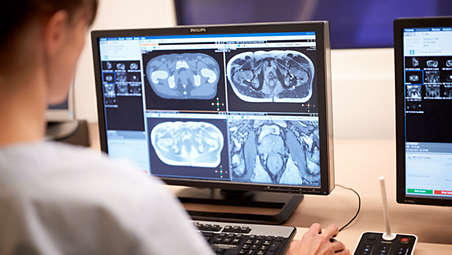- Drive speed, accuracy and consistency
-
Drive speed, accuracy and consistency
Because MRCAT Prostate requires input from MR images only, it reduces the organization and coordination of scans, eliminates the effort involved in MR-CT registration, and saves the patient from undergoing multiple procedures. Moreover, Auto-Contouring automates standard, labor-intensive and repetitive tasks, while at the same time reducing variability and errors caused by manual steps. This improves consistency and reproducibility - for more confidence in the planning process. - Fast, consistent imaging protocol
-
Fast, consistent imaging protocol
A dedicated, standardized imaging protocol includes a T1W mDIXON XD and a T2W TSE scan as source data for the generation of MRCAT (MR for Calculating ATtenuation) density maps and MR-based Auto-Contouring. Compressed SENSE acceleration keeps the total scan time short, which promotes patient comfort by minimizing time in the scanner and helps to boost productivity. - Automatic generation of synthetic CT images
-
Automatic generation of synthetic CT images
MRCAT Prostate automatically generates attenuation maps using the high-resolution mDIXON scan as source. Smart, validated algorithms enable automatic tissue segmentation and assignment of Hounsfield Units to deliver MRCAT images with CT-like density information for dose calculations - directly on the MR console. - Accuracy in dose planning
-
Accuracy in dose planning
The MRCAT Prostate scanning protocol and generation algorithms have been designed with the strict accuracy requirements of RT in mind. MRCAT Prostate images have high geometric accuracy* and validation studies have shown that MRCAT-based dose plans are robust and equivalent** to CT-based plans promoting confidence in dose planning. - Create accurate*** contours with little to no user interaction
-
Create accurate*** contours with little to no user interaction
MR-based Auto-Contouring automatically creates contours of prostate and OARs, reducing repetitive tasks and time spent, compared to manual methods. It uses dedicated MR imaging data based on the 3D T2W TSE and T1W mDIXON XD sequences and model-based adaptive algorithms. Auto-Contouring delineation of prostate and OARs has been found to be accurate (average distance < 1.5mm)*** in at least 70% of contours evaluated****. This significantly reduces the need for manual contouring or manual adaptations, while increasing consistency. - MRI as primary image set in treatment planning
-
MRI as primary image set in treatment planning
The MRCAT images generated on the MR console conform to the DICOM standard (modality CT) and hence can be exported to treatment planning systems (TPS) as the primary image dataset. Together with the generated contours (RTSTRUCT) and the ability to generate MRCAT-based digitally reconstructed radiographs (DRRs), you can replace your traditional CT-based workflow with an MRI-only radiotherapy workflow from imaging and planning to position verification. - Put Philips MR-only radiotherapy to work today
-
Put Philips MR-only radiotherapy to work today
To successfully bring MR-only radiotherapy into your clinical routine, we recognize that you must look beyond the imaging itself and address important steps such as patient marking, position verification, and quality assurance. We are prepared to support you throughout this process. To this end, we offer dedicated workflow descriptions, best practice sharing and tailored training support, designed to provide assistance as you adopt this new treatment paradigm.
Drive speed, accuracy and consistency

Drive speed, accuracy and consistency

Drive speed, accuracy and consistency
Fast, consistent imaging protocol

Fast, consistent imaging protocol

Fast, consistent imaging protocol
Automatic generation of synthetic CT images

Automatic generation of synthetic CT images

Automatic generation of synthetic CT images
Accuracy in dose planning

Accuracy in dose planning

Accuracy in dose planning
Create accurate*** contours with little to no user interaction

Create accurate*** contours with little to no user interaction

Create accurate*** contours with little to no user interaction
MRI as primary image set in treatment planning

MRI as primary image set in treatment planning

MRI as primary image set in treatment planning
Put Philips MR-only radiotherapy to work today

Put Philips MR-only radiotherapy to work today

Put Philips MR-only radiotherapy to work today
- Drive speed, accuracy and consistency
- Fast, consistent imaging protocol
- Automatic generation of synthetic CT images
- Accuracy in dose planning
- Drive speed, accuracy and consistency
-
Drive speed, accuracy and consistency
Because MRCAT Prostate requires input from MR images only, it reduces the organization and coordination of scans, eliminates the effort involved in MR-CT registration, and saves the patient from undergoing multiple procedures. Moreover, Auto-Contouring automates standard, labor-intensive and repetitive tasks, while at the same time reducing variability and errors caused by manual steps. This improves consistency and reproducibility - for more confidence in the planning process. - Fast, consistent imaging protocol
-
Fast, consistent imaging protocol
A dedicated, standardized imaging protocol includes a T1W mDIXON XD and a T2W TSE scan as source data for the generation of MRCAT (MR for Calculating ATtenuation) density maps and MR-based Auto-Contouring. Compressed SENSE acceleration keeps the total scan time short, which promotes patient comfort by minimizing time in the scanner and helps to boost productivity. - Automatic generation of synthetic CT images
-
Automatic generation of synthetic CT images
MRCAT Prostate automatically generates attenuation maps using the high-resolution mDIXON scan as source. Smart, validated algorithms enable automatic tissue segmentation and assignment of Hounsfield Units to deliver MRCAT images with CT-like density information for dose calculations - directly on the MR console. - Accuracy in dose planning
-
Accuracy in dose planning
The MRCAT Prostate scanning protocol and generation algorithms have been designed with the strict accuracy requirements of RT in mind. MRCAT Prostate images have high geometric accuracy* and validation studies have shown that MRCAT-based dose plans are robust and equivalent** to CT-based plans promoting confidence in dose planning. - Create accurate*** contours with little to no user interaction
-
Create accurate*** contours with little to no user interaction
MR-based Auto-Contouring automatically creates contours of prostate and OARs, reducing repetitive tasks and time spent, compared to manual methods. It uses dedicated MR imaging data based on the 3D T2W TSE and T1W mDIXON XD sequences and model-based adaptive algorithms. Auto-Contouring delineation of prostate and OARs has been found to be accurate (average distance < 1.5mm)*** in at least 70% of contours evaluated****. This significantly reduces the need for manual contouring or manual adaptations, while increasing consistency. - MRI as primary image set in treatment planning
-
MRI as primary image set in treatment planning
The MRCAT images generated on the MR console conform to the DICOM standard (modality CT) and hence can be exported to treatment planning systems (TPS) as the primary image dataset. Together with the generated contours (RTSTRUCT) and the ability to generate MRCAT-based digitally reconstructed radiographs (DRRs), you can replace your traditional CT-based workflow with an MRI-only radiotherapy workflow from imaging and planning to position verification. - Put Philips MR-only radiotherapy to work today
-
Put Philips MR-only radiotherapy to work today
To successfully bring MR-only radiotherapy into your clinical routine, we recognize that you must look beyond the imaging itself and address important steps such as patient marking, position verification, and quality assurance. We are prepared to support you throughout this process. To this end, we offer dedicated workflow descriptions, best practice sharing and tailored training support, designed to provide assistance as you adopt this new treatment paradigm.
Drive speed, accuracy and consistency

Drive speed, accuracy and consistency

Drive speed, accuracy and consistency
Fast, consistent imaging protocol

Fast, consistent imaging protocol

Fast, consistent imaging protocol
Automatic generation of synthetic CT images

Automatic generation of synthetic CT images

Automatic generation of synthetic CT images
Accuracy in dose planning

Accuracy in dose planning

Accuracy in dose planning
Create accurate*** contours with little to no user interaction

Create accurate*** contours with little to no user interaction

Create accurate*** contours with little to no user interaction
MRI as primary image set in treatment planning

MRI as primary image set in treatment planning

MRI as primary image set in treatment planning
Put Philips MR-only radiotherapy to work today

Put Philips MR-only radiotherapy to work today

Put Philips MR-only radiotherapy to work today
Documentation
-
Whitepaper (2)
-
Flyers (1)
-
Flyers
- Datasheet MRCAT Prostate + Auto-Contouring (266.8 kB)
-
Whitepaper (2)
-
Whitepaper
-
Flyers (1)
-
Flyers
- Datasheet MRCAT Prostate + Auto-Contouring (266.8 kB)
-
Whitepaper (2)
-
Flyers (1)
-
Flyers
- Datasheet MRCAT Prostate + Auto-Contouring (266.8 kB)
Specifications
- MRCAT Prostate and Auto-Contouring
-
MRCAT Prostate and Auto-Contouring Compatibility MR system - Ingenia 1.5T and 3.0T MR-RT, Ambition 1.5T MR-RT and Elition 3.0T MR-RT
-
- MRCAT Prostate and Auto-Contouring
-
MRCAT Prostate and Auto-Contouring Compatibility MR system - Ingenia 1.5T and 3.0T MR-RT, Ambition 1.5T MR-RT and Elition 3.0T MR-RT
-
- MRCAT Prostate and Auto-Contouring
-
MRCAT Prostate and Auto-Contouring Compatibility MR system - Ingenia 1.5T and 3.0T MR-RT, Ambition 1.5T MR-RT and Elition 3.0T MR-RT
-
Related products
Alternative products
-
Ingenia MR-RT XD
- Experience the MRI difference
- Position with precision
- Coil solutions for RT imaging
- MR-only radiotherapy planning
View product
-
MRCAT Brain
- MR-only sim for primary and metastatic tumors in the brain
- Single-scan approach
- Automatic generation of synthetic CT images using AI
- Accuracy in dose planning
View product
-
MRCAT Pelvis
- MR-only sim for pelvic radiotherapy planning
- Robust, consistent imaging protocol
- Continuous Hounsfield units
- Accuracy in dose planning
View product
-
MRCAT Head and Neck
- MR-only sim for soft tissue tumors in the head and neck region
- Short scan times promote patient comfort
- Automatic generation of CT-like density information using AI
- Accuracy in dose planning
View product
-
Ingenia MR-RT XD
The Philips Ingenia MR-RT XD platform harnesses the power and value of MRI for radiation therapy planning. It has been designed around the needs of radiation oncology, with ease-of-use, streamlined integration, and versatility in mind. Central to that concept is the ability to define a tailored approach with customizable functionality that meets your individual clinical, workflow, and budgetary requirements – all to provide better patient care.
View product
-
MRCAT Brain
MRCAT Brain clinical application allows the use of MRI as the primary imaging modality for radiotherapy planning of primary and metastatic tumors in the brain without the need for CT. Detailed anatomical information for contouring and attenuation maps for dose calculations are both obtained from a single, submillimeter resolution 3D T1W mDIXON MR sequence. Artificial Intelligence (AI) is used for fast computation of continuous Hounsfield units directly on the MR console.
View product
-
MRCAT Pelvis
MRCAT Pelvis lets you plan radiation therapy using MRI as a single modality solution. Within just one MR exam, MRCAT Pelvis provides excellent soft-tissue contrast for target and OAR delineation, and continuous Hounsfield units for dose calculations. MRCAT (MR for Calculating ATtenuation) data can be used for export to treatment planning systems for CT-equivalent** dose calculations. In addition, MR-based imaging enables CBCT-based positioning based on soft-tissue contrast with the look and feel of CT.
View product
See all related products
- *Accurate means: MRCAT provides < ± 1 mm total geometric accuracy of image data in < 20 cm Diameter Spherical Volume (DSV) and < ± 2 mm total geometric accuracy of image data in < 40 cm Diameter Spherical Volume (DSV))*. *Limited to 32 cm in z-direction in more than 95% of the points within the volume
- **The simulated dose based on MRCAT images does not differ in >95% of prostate cancer patients (Gamma analysis criterion 3%/3 mm realized in 99% of voxels exceeding 75% of the maximum dose) when compared with the CT-based plan for EBRT.
- ***Accurate means 95th percentile modified Hausdorff distance <5mm compared to contours made by experts manually. Average distance is <1.5 mm and is measured as average modified Hausdorff distance compared to contours made by experts manually.
- **** Based on 49 cases (each for anatomical prostate, bladder, rectum, penile bulb and femur heads)




